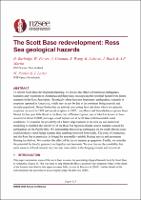| dc.description.abstract | To inform Scott Base development planning, we discuss the effects of historical earthquakes, tsunamis and volcanism on Antarctica and then focus on assessing the potential hazard from future tsunamis in the Ross Sea region. Historically, there have not been many earthquakes, tsunamis or eruptions reported in Antarctica, which may in part be due to the continent being sparsely and recently populated. Mount Erebus has an actively convecting lava lake from which two phreatic eruptions occurred in 1993 and an ash eruption in 1997. Lava flows and Strombolian eruptions from Mount Erebus pose little threat to the Base, but a Plinian eruption, one of which is known to have occurred at about 39,000 years ago, could deposit ash at Scott Base with favourable wind conditions. To examine the possibility of a future large tsunami in the area we use numerical modelling to establish the sensitivity of the Ross Sea region to distant-source tsunamis caused by earthquakes on the Pacific Rim. We demonstrate that a large earthquake on the south Mexico coast could produce a much larger tsunami than anything observed historically. The coast of Antarctica, and the Ross Sea in particular, is fringed by seasonally-variable floating sea ice and permanent floating ice shelves. We consider the effect of the ice on tsunami propagation. Finally, we consider the potential for locally generated earthquakes and tsunamis. We also discuss the possibility that some sources of local tsunami may become more active with changing climate and ice-retreat. | |

